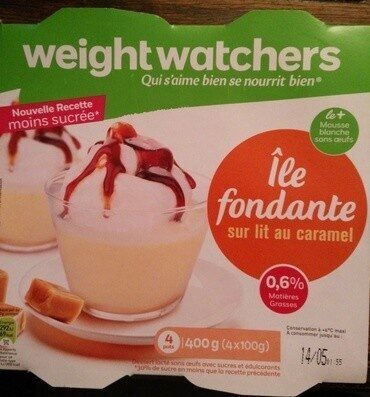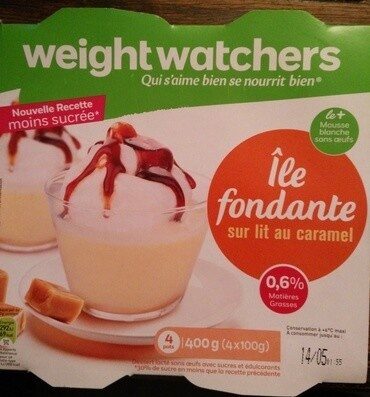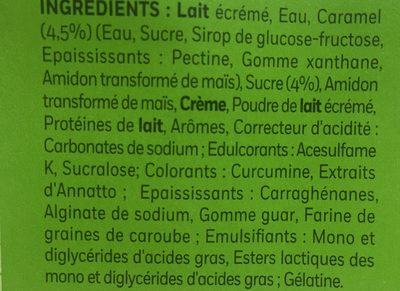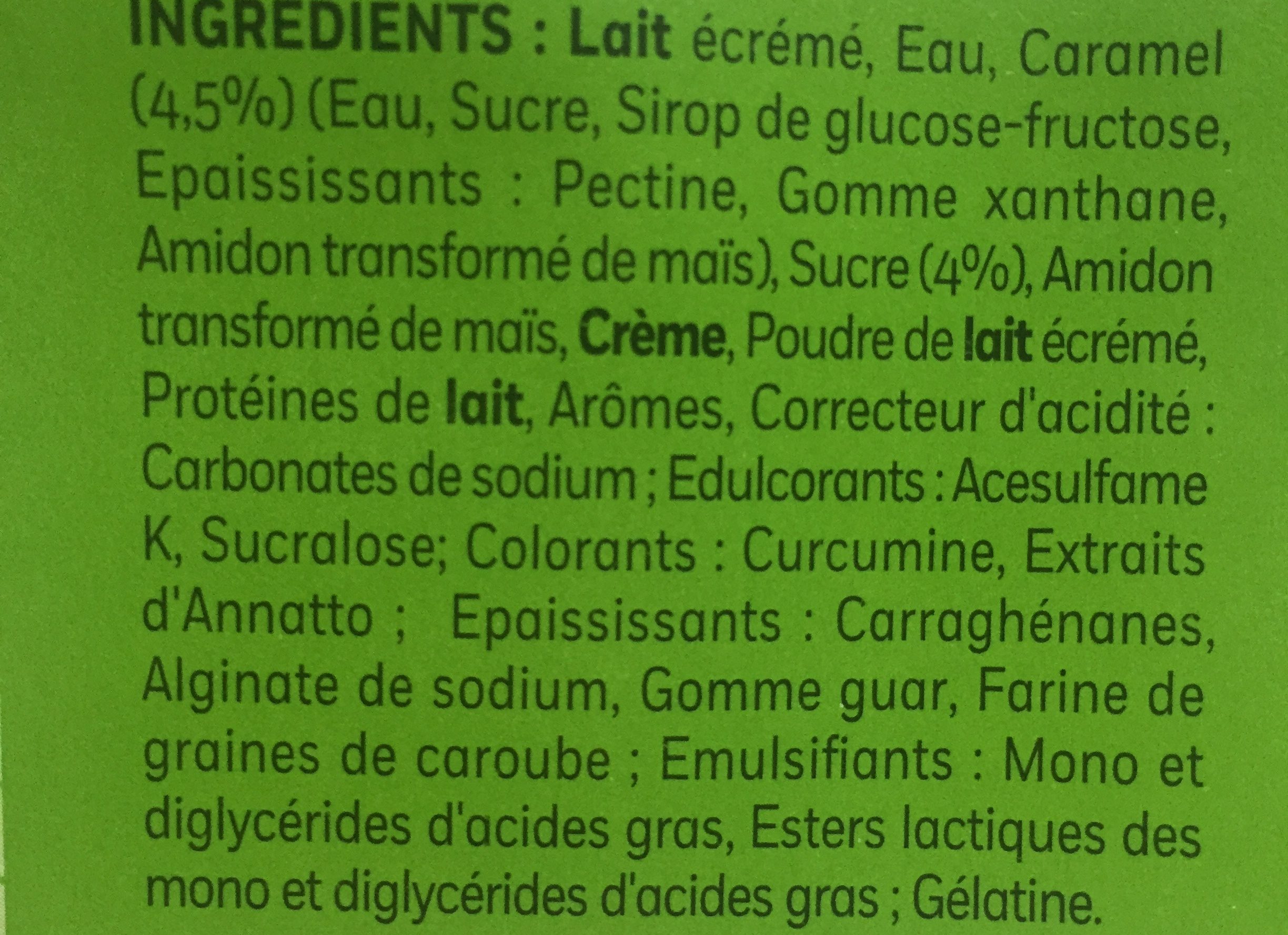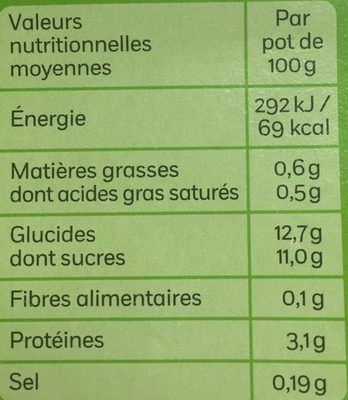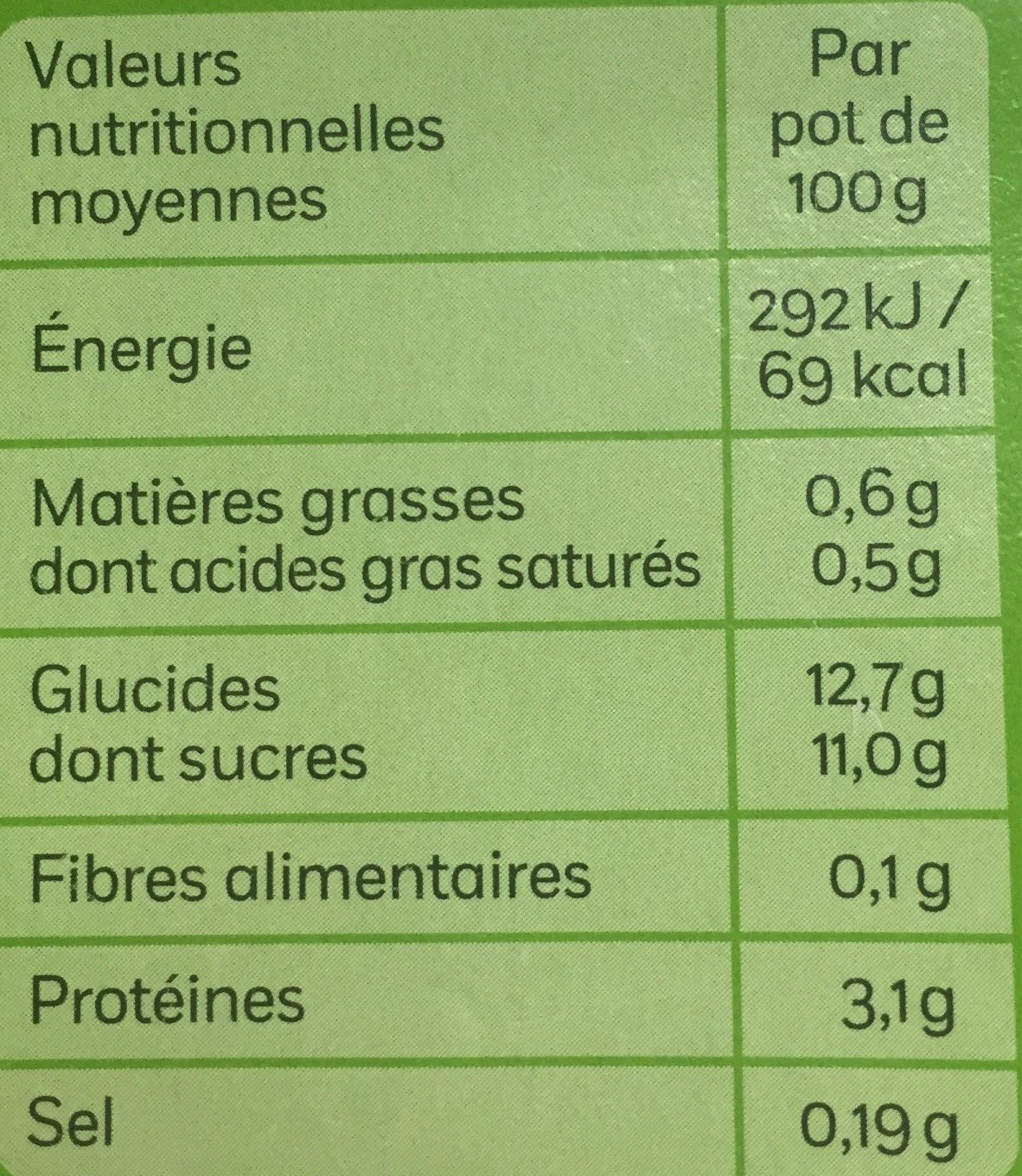Help us make food transparency the norm!
As a non-profit organization, we depend on your donations to continue informing consumers around the world about what they eat.
The food revolution starts with you!
Île Fondante sur lit de caramel (0.6% MG) - WeightWatchers - 400 g
Île Fondante sur lit de caramel (0.6% MG) - WeightWatchers - 400 g
This product page is not complete. You can help to complete it by editing it and adding more data from the photos we have, or by taking more photos using the app for Android or iPhone/iPad. Thank you!
×
Some of the data for this product has been provided directly by the manufacturer YOPLAIT FRANCE.
Barcode: 3329770051287 (EAN / EAN-13)
Common name: Dessert lacté sans œufs avec sucres et édulcorants
Quantity: 400 g
Packaging: Plastic, Pot, Cardboard
Brands: WeightWatchers, Weight watchers, Yoplait
Categories: Dairies, Snacks, Desserts, Sweet snacks, Dairy desserts, Biscuits and cakes, Pastries, Floating island, fr:Desserts lactés aux œufs
Labels, certifications, awards: No preservatives, Made in France
Manufacturing or processing places: France
Traceability code: FR 38.544.004 CE - Vienne (Isère, France)
Stores: Auchan, Magasins U
Countries where sold: France
Matching with your preferences
Health
Ingredients
-
34 ingredients
French: LAIT écrémé, Eau, Caramel (4.5%) (Eau, Sucre, Sirop de glucose-fructose, Epaississants : Pectine ; Gomme xanthane, Amidon transformé de maïs), Sucre (4%), Amidon transformé de maïs, CREME, Poudre de LAIT écrémé, Protéines de LAIT, Arômes, Correcteur d'acidité : Carbonates de sodium; Edulcorants : Acesulfame K, Sucralose; Colorants : Curcumine, Extraits d'Annatto; Epaississants : Carraghénanes, Alginate de sodium, Gomme guar, Farine de graines de caroube ; Emulsifiants : Mono et diglycérides d'acides gras, Esters LACTIQUES des mono et diglycérides d'acides gras; Gélatine. LAIT D'ORIGINE FRANCEAllergens: Milk
Food processing
-
Ultra processed foods
Elements that indicate the product is in the 4 - Ultra processed food and drink products group:
- Additive: E100 - Curcumin
- Additive: E14XX - Modified Starch
- Additive: E401 - Sodium alginate
- Additive: E407 - Carrageenan
- Additive: E412 - Guar gum
- Additive: E415 - Xanthan gum
- Additive: E428 - Gelatine
- Additive: E440 - Pectins
- Additive: E471 - Mono- and diglycerides of fatty acids
- Additive: E472b - Lactic acid esters of mono- and diglycerides of fatty acids
- Additive: E950 - Acesulfame k
- Additive: E955 - Sucralose
- Ingredient: Colour
- Ingredient: Emulsifier
- Ingredient: Flavouring
- Ingredient: Glucose
- Ingredient: Milk proteins
- Ingredient: Sweetener
- Ingredient: Thickener
Food products are classified into 4 groups according to their degree of processing:
- Unprocessed or minimally processed foods
- Processed culinary ingredients
- Processed foods
- Ultra processed foods
The determination of the group is based on the category of the product and on the ingredients it contains.
Additives
-
E407 - Carrageenan
Carrageenan (E407), derived from red seaweed, is widely employed in the food industry as a gelling, thickening, and stabilizing agent, notably in dairy and meat products.
It can exist in various forms, each imparting distinct textural properties to food.
However, its degraded form, often referred to as poligeenan, has raised health concerns due to its potential inflammatory effects and its classification as a possible human carcinogen (Group 2B) by the International Agency for Research on Cancer (IARC).
Nevertheless, food-grade carrageenan has been deemed safe by various regulatory bodies when consumed in amounts typically found in food.
-
E412 - Guar gum
Guar gum (E412) is a natural food additive derived from guar beans.
This white, odorless powder is valued for its remarkable thickening and stabilizing properties, making it a common ingredient in various food products, including sauces, dressings, and ice creams.
When used in moderation, guar gum is considered safe for consumption, with no known adverse health effects.
-
E415 - Xanthan gum
Xanthan gum (E415) is a natural polysaccharide derived from fermented sugars, often used in the food industry as a thickening and stabilizing agent.
This versatile food additive enhances texture and prevents ingredient separation in a wide range of products, including salad dressings, sauces, and gluten-free baked goods.
It is considered safe for consumption even at high intake amounts.
-
E440 - Pectins
Pectins (E440) are natural carbohydrates, predominantly found in fruits, that act as gelling agents in the food industry, creating the desirable jelly-like texture in jams, jellies, and marmalades.
Pectins stabilize and thicken various food products, such as desserts, confectioneries, and beverages, ensuring a uniform consistency and quality.
Recognized as safe by various health authorities, pectins have been widely used without notable adverse effects when consumed in typical dietary amounts.
-
E471 - Mono- and diglycerides of fatty acids
Mono- and diglycerides of fatty acids (E471), are food additives commonly used as emulsifiers in various processed foods.
These compounds consist of glycerol molecules linked to one or two fatty acid chains, which help stabilize and blend water and oil-based ingredients. E471 enhances the texture and shelf life of products like margarine, baked goods, and ice cream, ensuring a smooth and consistent texture.
It is generally considered safe for consumption within established regulatory limits.
-
E500 - Sodium carbonates
Sodium carbonates (E500) are compounds commonly used in food preparation as leavening agents, helping baked goods rise by releasing carbon dioxide when they interact with acids.
Often found in baking soda, they regulate the pH of food, preventing it from becoming too acidic or too alkaline. In the culinary world, sodium carbonates can also enhance the texture and structure of foods, such as noodles, by modifying the gluten network.
Generally recognized as safe, sodium carbonates are non-toxic when consumed in typical amounts found in food.
-
E950 - Acesulfame k
Acesulfame potassium: Acesulfame potassium - AY-see-SUL-faym-, also known as acesulfame K -K is the symbol for potassium- or Ace K, is a calorie-free sugar substitute -artificial sweetener- often marketed under the trade names Sunett and Sweet One. In the European Union, it is known under the E number -additive code- E950. It was discovered accidentally in 1967 by German chemist Karl Clauss at Hoechst AG -now Nutrinova-. In chemical structure, acesulfame potassium is the potassium salt of 6-methyl-1‚2,3-oxathiazine-4-3H--one 2‚2-dioxide. It is a white crystalline powder with molecular formula C4H4KNO4S and a molecular weight of 201.24 g/mol.Source: Wikipedia
-
E955 - Sucralose
Sucralose: Sucralose is an artificial sweetener and sugar substitute. The majority of ingested sucralose is not broken down by the body, so it is noncaloric. In the European Union, it is also known under the E number E955. It is produced by chlorination of sucrose. Sucralose is about 320 to 1‚000 times sweeter than sucrose, three times as sweet as both aspartame and acesulfame potassium, and twice as sweet as sodium saccharin. Evidence of benefit is lacking for long-term weight loss with some data supporting weight gain and heart disease risks.It is stable under heat and over a broad range of pH conditions. Therefore, it can be used in baking or in products that require a long shelf life. The commercial success of sucralose-based products stems from its favorable comparison to other low-calorie sweeteners in terms of taste, stability, and safety. Common brand names of sucralose-based sweeteners are Splenda, Zerocal, Sukrana, SucraPlus, Candys, Cukren, and Nevella. Canderel Yellow also contains sucralose, but the original Canderel and Green Canderel do not.Source: Wikipedia
Ingredients analysis
-
May contain palm oil
Ingredients that may contain palm oil: E471, E472b
-
Non-vegan
Non-vegan ingredients: Skimmed milk, Cream, Skimmed milk powder, Milk proteins, E428, Milk
-
Non-vegetarian
Non-vegetarian ingredients: E428
-
Details of the analysis of the ingredients
fr: LAIT écrémé, Eau, Caramel 4.5% (Eau, Sucre, Sirop de glucose-fructose, Epaississants (Pectine), Gomme xanthane, Amidon transformé de maïs), Sucre 4%, Amidon transformé de maïs, CREME, Poudre de LAIT écrémé, Protéines de LAIT, Arômes, Correcteur d'acidité (Carbonates de sodium), Edulcorants (Acesulfame K), Sucralose, Colorants (Curcumine), d'Annatto, Epaississants (Carraghénanes), Alginate de sodium, Gomme guar, Farine de graines de caroube, Emulsifiants (mono- et diglycérides d'acides gras), Esters LACTIQUES des mono- et diglycérides d'acides gras, Gélatine, LAIT- LAIT écrémé -> en:skimmed-milk - vegan: no - vegetarian: yes - ciqual_proxy_food_code: 19051 - percent_min: 4.54545454545455 - percent_max: 87
- Eau -> en:water - vegan: yes - vegetarian: yes - ciqual_food_code: 18066 - percent_min: 4.5 - percent_max: 45.75
- Caramel -> en:e150 - vegan: yes - vegetarian: yes - percent_min: 4.5 - percent: 4.5 - percent_max: 4.5
- Eau -> en:water - vegan: yes - vegetarian: yes - ciqual_food_code: 18066 - percent_min: 0.75 - percent_max: 4.5
- Sucre -> en:sugar - vegan: yes - vegetarian: yes - ciqual_proxy_food_code: 31016 - percent_min: 0 - percent_max: 2.25
- Sirop de glucose-fructose -> en:glucose-fructose-syrup - vegan: yes - vegetarian: yes - ciqual_food_code: 31077 - percent_min: 0 - percent_max: 1.5
- Epaississants -> en:thickener - percent_min: 0 - percent_max: 1.125
- Pectine -> en:e440a - vegan: yes - vegetarian: yes - percent_min: 0 - percent_max: 1.125
- Gomme xanthane -> en:e415 - vegan: yes - vegetarian: yes - percent_min: 0 - percent_max: 0.9
- Amidon transformé de maïs -> en:modified-corn-starch - vegan: yes - vegetarian: yes - ciqual_food_code: 9510 - percent_min: 0 - percent_max: 0.75
- Sucre -> en:sugar - vegan: yes - vegetarian: yes - ciqual_proxy_food_code: 31016 - percent_min: 4 - percent: 4 - percent_max: 4
- Amidon transformé de maïs -> en:modified-corn-starch - vegan: yes - vegetarian: yes - ciqual_food_code: 9510 - percent_min: 0 - percent_max: 4
- CREME -> en:cream - vegan: no - vegetarian: yes - ciqual_food_code: 19402 - percent_min: 0 - percent_max: 4
- Poudre de LAIT écrémé -> en:skimmed-milk-powder - vegan: no - vegetarian: yes - ciqual_food_code: 19054 - percent_min: 0 - percent_max: 4
- Protéines de LAIT -> en:milk-proteins - vegan: no - vegetarian: yes - percent_min: 0 - percent_max: 4
- Arômes -> en:flavouring - vegan: maybe - vegetarian: maybe - percent_min: 0 - percent_max: 4
- Correcteur d'acidité -> en:acidity-regulator - percent_min: 0 - percent_max: 4
- Carbonates de sodium -> en:e500 - vegan: yes - vegetarian: yes - percent_min: 0 - percent_max: 4
- Edulcorants -> en:sweetener - percent_min: 0 - percent_max: 4
- Acesulfame K -> en:e950 - vegan: yes - vegetarian: yes - percent_min: 0 - percent_max: 4
- Sucralose -> en:e955 - vegan: yes - vegetarian: yes - percent_min: 0 - percent_max: 4
- Colorants -> en:colour - percent_min: 0 - percent_max: 4
- Curcumine -> en:e100 - vegan: yes - vegetarian: yes - percent_min: 0 - percent_max: 4
- d'Annatto -> en:e160b - vegan: yes - vegetarian: yes - percent_min: 0 - percent_max: 4
- Epaississants -> en:thickener - percent_min: 0 - percent_max: 4
- Carraghénanes -> en:e407 - vegan: yes - vegetarian: yes - percent_min: 0 - percent_max: 4
- Alginate de sodium -> en:e401 - vegan: yes - vegetarian: yes - percent_min: 0 - percent_max: 4
- Gomme guar -> en:e412 - vegan: yes - vegetarian: yes - percent_min: 0 - percent_max: 4
- Farine de graines de caroube -> en:carob-seed-flour - vegan: yes - vegetarian: yes - ciqual_proxy_food_code: 9410 - percent_min: 0 - percent_max: 4
- Emulsifiants -> en:emulsifier - percent_min: 0 - percent_max: 4
- mono- et diglycérides d'acides gras -> en:e471 - vegan: maybe - vegetarian: maybe - from_palm_oil: maybe - percent_min: 0 - percent_max: 4
- Esters LACTIQUES des mono- et diglycérides d'acides gras -> en:e472b - vegan: maybe - vegetarian: maybe - from_palm_oil: maybe - percent_min: 0 - percent_max: 4
- Gélatine -> en:e428 - vegan: no - vegetarian: no - percent_min: 0 - percent_max: 4
- LAIT -> en:milk - vegan: no - vegetarian: yes - ciqual_proxy_food_code: 19051 - percent_min: 0 - percent_max: 4
Nutrition
-
Good nutritional quality
⚠ ️Warning: the amount of fruits, vegetables and nuts is not specified on the label, it was estimated from the list of ingredients: 0This product is not considered a beverage for the calculation of the Nutri-Score.
Positive points: 1
- Proteins: 1 / 5 (value: 3.1, rounded value: 3.1)
- Fiber: 0 / 5 (value: 0.1, rounded value: 0.1)
- Fruits, vegetables, nuts, and colza/walnut/olive oils: 0 / 5 (value: 0, rounded value: 0)
Negative points: 2
- Energy: 0 / 10 (value: 292, rounded value: 292)
- Sugars: 2 / 10 (value: 11, rounded value: 11)
- Saturated fat: 0 / 10 (value: 0.5, rounded value: 0.5)
- Sodium: 0 / 10 (value: 76, rounded value: 76)
The points for proteins are counted because the negative points are less than 11.
Nutritional score: (2 - 1)
Nutri-Score:
-
Nutrient levels
-
Fat in low quantity (0.6%)
What you need to know- A high consumption of fat, especially saturated fats, can raise cholesterol, which increases the risk of heart diseases.
Recommendation: Limit the consumption of fat and saturated fat- Choose products with lower fat and saturated fat content.
-
Saturated fat in low quantity (0.5%)
What you need to know- A high consumption of fat, especially saturated fats, can raise cholesterol, which increases the risk of heart diseases.
Recommendation: Limit the consumption of fat and saturated fat- Choose products with lower fat and saturated fat content.
-
Sugars in moderate quantity (11%)
What you need to know- A high consumption of sugar can cause weight gain and tooth decay. It also augments the risk of type 2 diabetes and cardio-vascular diseases.
Recommendation: Limit the consumption of sugar and sugary drinks- Sugary drinks (such as sodas, fruit beverages, and fruit juices and nectars) should be limited as much as possible (no more than 1 glass a day).
- Choose products with lower sugar content and reduce the consumption of products with added sugars.
-
Salt in low quantity (0.19%)
What you need to know- A high consumption of salt (or sodium) can cause raised blood pressure, which can increase the risk of heart disease and stroke.
- Many people who have high blood pressure do not know it, as there are often no symptoms.
- Most people consume too much salt (on average 9 to 12 grams per day), around twice the recommended maximum level of intake.
Recommendation: Limit the consumption of salt and salted food- Reduce the quantity of salt used when cooking, and don't salt again at the table.
- Limit the consumption of salty snacks and choose products with lower salt content.
-
-
Nutrition facts
Nutrition facts As sold
for 100 g / 100 mlCompared to: Floating island Energy 292 kj
(69 kcal)-48% Fat 0.6 g -82% Saturated fat 0.5 g -70% Carbohydrates 12.7 g -40% Sugars 11 g -44% Fiber 0.1 g +21% Proteins 3.1 g -34% Salt 0.19 g +28% Alcohol 0 % vol Fruits‚ vegetables‚ nuts and rapeseed‚ walnut and olive oils (estimate from ingredients list analysis) 0 %
Environment
-
Eco-Score B - Low environmental impact
⚠ ️Select a country in order to include the full impact of transportation.The Eco-Score is an experimental score that summarizes the environmental impacts of food products.→ The Eco-Score was initially developped for France and it is being extended to other European countries. The Eco-Score formula is subject to change as it is regularly improved to make it more precise and better suited to each country.Life cycle analysis
-
Average impact of products of the same category: A (Score: 85/100)
Category: Floating island (meringue poached in milk and served in a light custard cream), refrigerated
Category: Floating island (meringue poached in milk and served in a light custard cream), refrigerated
- PEF environmental score: 0.24 (the lower the score, the lower the impact)
- including impact on climate change: 1.83 kg CO2 eq/kg of product
Stage Impact Agriculture
68.2 %Processing
13.7 %Packaging
6.5 %Transportation
6.8 %Distribution
3.8 %Consumption
1.0 %
Bonuses and maluses
-
Origins of ingredients with a high impact
Malus: -5
Environmental policy: -5
Transportation: 0
Origin of the product and/or its ingredients % of ingredients Impact Unknown 100 %High France 0 %Medium
-
Packaging with a medium impact
Malus: -11
Shape Material Recycling Impact Pot Plastic High Unknown Cardboard Low ⚠ ️ The information about the packaging of this product is not sufficiently precise (exact shapes and materials of all components of the packaging).⚠ ️ For a more precise calculation of the Eco-Score, you can modify the product page and add them.
If you are the manufacturer of this product, you can send us the information with our free platform for producers.
Eco-Score for this product
-
Impact for this product: B (Score: 69/100)
Product: Île Fondante sur lit de caramel (0.6% MG) - WeightWatchers - 400 g
Life cycle analysis score: 85
Sum of bonuses and maluses: -16
Final score: 69/100
-
Carbon footprint
-
Equal to driving 0.9 km in a petrol car
183 g CO² per 100g of product
The carbon emission figure comes from ADEME's Agribalyse database, for the category: Floating island (meringue poached in milk and served in a light custard cream), refrigerated (Source: ADEME Agribalyse Database)
Stage Impact Agriculture
65.9 %Processing
9.9 %Packaging
10.2 %Transportation
11.6 %Distribution
2.0 %Consumption
0.4 %
Packaging
-
Packaging with a medium impact
-
Packaging parts
Pot (Plastic)
(Cardboard)
-
Packaging materials
Material % Packaging weight Packaging weight per 100 g of product Paper or cardboard Plastic Total
-
Transportation
-
Origins of ingredients
Origins of ingredients with a high impact
Origin of the product and/or its ingredients % of ingredients Impact Unknown 100 %High France 0 %Medium
Other information
Conservation conditions: Conservation entre 0°C et +6°C max
Customer service: Service Consommateurs, TSA 40100 - 92649 Boulogne Billancourt Cedex
Report a problem
-
Incomplete or incorrect information?
Category, labels, ingredients, allergens, nutritional information, photos etc.
If the information does not match the information on the packaging, please complete or correct it. Open Food Facts is a collaborative database, and every contribution is useful for all.
Data sources
The manufacturer YOPLAIT FRANCE uses CodeOnline Food to automatically transmit data and photos for its products.
Manufacturers can use the Open Food Facts free plaform for producers to access and complete this data, and to obtain reports, analysis and product improvements opportunities (e.g. better Nutri-Score).
Product added on by openfoodfacts-contributors
Last edit of product page on by segundo.
Product page also edited by beniben, desan, kiliweb, magasins-u, nezlaine-63, org-yoplait-france, packbot, roboto-app, sebleouf, sylviapierre, tacite, yuka.WHJsZUUvbGUvNkVWbmNBNjhrN0g1ZE12K0lTV2ZXNldFOGtJSVE9PQ, yuka.sY2b0xO6T85zoF3NwEKvlnJkU8PHqWzEEkHTi3KQx8_fKMHLRcFp2oqjGKo.
